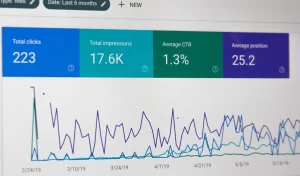SEO traffic is the organic visitors your website gains from search engine results. At Octopuswriters, we know that understanding how SEO traffic functions and using tried-and-true strategies can greatly enhance your site’s visibility, attract the right audience, and increase conversions. In this article, Octopuswriters will guide you through effective methods to efficiently boost your SEO traffic.
What is SEO Traffic?
SEO traffic is generated when users visit a website by finding it through search engines like Google or Bing. They enter specific keywords, and the search engines display relevant websites in response. A website that ranks higher on the search results page is more likely to receive increased SEO traffic. This kind of traffic is highly beneficial because it is both targeted and organic, meaning it reaches users who are actively searching for related information without incurring costs like paid ads.

To get a full understanding of your SEO performance, it’s essential to combine website visit data with goal-completion metrics. While SEO is often treated as a standalone activity, it should be viewed as an integral part of your website’s overall performance and part of a broader marketing strategy. By tracking these key performance indicators (KPIs) on a Google Analytics dashboard, your search marketing team gains valuable context and insights.
SEO traffic can be categorized into good SEO traffic and bad SEO traffic:
What is bad SEO traffic?
Similarly, there’s no definitive “bad” SEO traffic. However, if you’re not seeing the growth you expect, it might be time to refine your content strategy to bring in more targeted visitors. Issues like slow loading times, high bounce rates, or sitemap errors could also point to underlying problems with your website’s functionality, which may be affecting its ranking on Google. To address this, consider your website from the user’s perspective and make sure it’s fully optimized to meet their needs and enhance their experience.
What is good SEO traffic?
The importance of your webpage’s SEO largely depends on the industry you’re in. Some topics naturally have much higher search volumes than others, making it impossible to apply a one-size-fits-all value. However, when assessing your SEO traffic metrics, it’s crucial to compare them with your company’s broader digital and search marketing goals. A successful SEO strategy should not only boost traffic but also align with your larger business objectives, driving overall website growth.
Key Terms in SEO Traffic
Understanding SEO traffic terminology is essential for anyone looking to improve their website’s performance. These key terms help clarify the different types of traffic and ranking metrics that can impact your site’s visibility and growth.

- Traffic: Refers to the number of visitors coming to your website.
- Organic Search: These are the search results that appear naturally, based on their relevance to the user’s query. Often referred to as “natural” results, achieving a high ranking in organic search is the primary goal of SEO.
- Paid Search: Paid search marketing involves advertising in the sponsored sections of a search engine or partner site. You pay either per click (PPC) or, less commonly, per impression (CPM), when your ad is displayed.
- Traffic Rank: This is a metric that shows how much traffic your site receives in comparison to other websites. Tools like Alexa can help you check your traffic rank on a global scale.
Benchmark of SEO Traffic
At Octopuswriters, we believe that when it comes to benchmarking SEO traffic, relying on a single source isn’t enough. Avinash Kaushik from Occam’s Razor suggests that the best starting point is your own data. Analyze month-over-month trends and year-over-year performance to get a clear picture of your organic and paid search results. While external industry reports can still offer valuable insights, they should be paired with competitor data for a more comprehensive view. Kaushik’s preferred approach combines industry performance as a foundational layer of context, then adds a second layer by focusing on top competitors to get a clearer benchmark.
SEO Traffic Challenges

When managing SEO, it’s crucial to recognize the dynamic nature of both Google and your target market. To stay competitive, you need to constantly adapt to shifting technologies, algorithm updates, and changes in user behavior. Below are some key challenges to keep in mind when navigating the world of SEO traffic:
- Google and Market Evolution: Neither Google nor your market remains static. You must continuously adapt to an ever-changing environment with evolving technologies, Google’s frequent algorithm updates, shifting consumer behaviors, and the rise of new apps and devices. Staying flexible and proactive is essential to keep up with these developments.
- KPI Limitations: While SEO KPIs provide valuable insights into your efforts, they should not be viewed in isolation. A single metric can’t give you the full picture of your SEO performance. It’s crucial to combine KPIs with other metrics to gain a comprehensive understanding of your progress and identify areas for improvement.
- Shifts in SERPs: Google’s search results pages (SERPs) are constantly changing. With the rise of vertical and universal search, along with Google promoting its own products at the top of the page, organic results are often pushed further down. This means you need to be realistic with your SEO expectations and strategies to maintain visibility.
- Increased Competition: As more businesses invest in SEO, the competition for ranking on valuable keywords becomes fiercer. You’ll need to continuously optimize your strategy to outperform rivals and stay ahead in the rankings.
- Mobile-First Indexing: With Google’s shift toward mobile-first indexing, ensuring that your website is fully optimized for mobile devices is no longer optional. Mobile performance now plays a critical role in determining your SEO traffic and ranking potential.
By staying aware of these challenges and adapting your approach, you can build a resilient SEO strategy that continues to drive traffic even in an ever-evolving digital landscape.
SEO Traffic Best Practices
There are numerous effective tools available to help you gain better insights into your SEO traffic. While most digital marketers rely on Google Analytics as a primary source for SEO data, there are other tools that can enhance your analysis. For instance, Alexa is particularly useful for understanding traffic metrics and sources, giving you a broader view of how your site performs.
Additionally, combining data from multiple sources can provide a more comprehensive overview. Moz, for example, can be paired with performance metrics from Google Analytics, Mixpanel, or even custom data sources. Using a platform like Octopuswriters, you can consolidate all this information into a single dashboard for easy monitoring and analysis.
Because search engines are always changing, it’s crucial to keep a close eye on these metrics over time. SEO dashboards are especially helpful for staying updated on performance trends and making adjustments as necessary to maintain or improve rankings.
How to Monitor SEO Traffic in Real-time

Keeping an eye on your SEO traffic in real-time is essential to understanding your website’s current performance and allows you to act quickly in response to any changes or issues. Here are some key methods to help you track your SEO traffic as it happens:
- Google Analytics: Google Analytics is a robust platform offering real-time insights into your site’s activity. Using the “Real-Time” reports, you can track active users, page views, traffic sources, and even visitor locations as they happen. This allows you to assess how well your content is performing in the moment.
- Google Search Console: While not a real-time tool, Google Search Console provides critical data on search queries, click-through rates (CTR), and indexing issues. It’s a valuable tool for tracking SEO performance over time and ensuring your site is functioning well in search results.
- Octopuswritersand SEO Dashboards: Tools like Octopuswriters allow you to pull together data from multiple sources, such as Google Analytics and other platforms, into a real-time SEO dashboard. This consolidated view enables you to track traffic metrics, keyword rankings, and SERP performance in real time, giving you the ability to quickly adapt your strategies.
- Alerts and Notifications: Setting up alerts with tools like Google Analytics or Octopuswriters can notify you of sudden traffic changes, such as spikes or drops, so you can respond immediately.
By using these tools and techniques, you’ll be able to monitor your SEO traffic in real-time and ensure that your website continues to perform at its best.
How Does SEO Generate Traffic?
SEO helps drive traffic by making it easier for search engines to understand your website’s content and decide where it should be ranked in search results. By optimizing for SEO, your site becomes more visible to users searching for relevant terms, increasing the chances of appearing in searches that matter to your target audience.
The more SEO-friendly your website is, the better its chances of ranking higher on search engine results pages (SERPs). Higher rankings translate to more clicks and visits from organic search traffic. But the value of SEO traffic extends beyond just increased visibility and visits.

On-Page SEO
On-page SEO involves optimizing everything within your website, such as incorporating relevant keywords, refining meta tags, using proper headers, and optimizing image alt texts. By doing so, you’re making it easier for search engines to index your pages and understand the content. Additionally, improving site performance, mobile-friendliness, and user experience are key elements of on-page SEO that boost your site’s rankings.
Off-Page SEO
Off-page SEO focuses on activities outside of your site that influence its rankings, such as building high-quality backlinks, promoting content on social media, and earning brand mentions. These external factors signal to search engines that your site is trustworthy and authoritative, helping to enhance its position in search results.
Combining both on-page and off-page SEO strategies ensures that your website not only gains higher visibility but also attracts sustainable, organic traffic, helping you achieve long-term success.
What Are the Benefits of SEO Traffic?
SEO traffic offers a range of significant benefits that can enhance your website’s performance and support long-term growth. Here are some of the key advantages:
- It’s cost-effective: Unlike pay-per-click (PPC) marketing, where you pay for every click or impression, SEO traffic is free. All you need to do is create valuable content and optimize your website for search engines.
- It’s highly targeted: SEO helps attract visitors who are actively searching for the products, services, or solutions you offer. This means they’re more likely to convert, as they already have a need for what you provide.
- It’s long-lasting: A well-executed SEO strategy can maintain and even improve your rankings over time. This ensures a consistent flow of traffic without the ongoing expense of paid advertising.
- It’s trackable: SEO traffic is easy to monitor and analyze through tools like Google Analytics, Google Search Console, and Semrush. This allows you to measure performance and refine your strategy based on real data.
- It builds credibility and trust: Websites that rank highly in organic search results are often perceived as more trustworthy and credible by users. Good SEO helps establish your brand as an authority in your industry, boosting user confidence in your site and offerings.

- It enhances user experience: SEO isn’t just about keywords—it also focuses on improving website performance, such as load times, mobile-friendliness, and overall usability. By optimizing your site for SEO, you’re also providing a better user experience, which can lead to more engagement and higher conversions.
- It drives local traffic: Local SEO helps attract nearby customers by optimizing for location-based keywords. This is especially important for businesses with a physical presence, as it can drive in-store visits and local sales.
- It complements other marketing strategies: SEO works hand-in-hand with other digital marketing efforts like content marketing, social media, and paid ads. Optimizing content for SEO increases visibility, while sharing that content on social platforms amplifies its reach.
Explaining SEO Traffic to Your Clients
While SEO is a widely recognized and valuable tool for businesses, its significance can vary depending on the client’s goals. For some, it’s an absolute must, while for others, it might not be the immediate focus.
Consider a pre-revenue SaaS company, for example, that’s working to attract investors. They might not have the patience for the gradual results of an organic SEO strategy, as their immediate needs are different.
That’s why it’s crucial to understand what your clients aim to achieve—whether they need quick foot traffic to their brick-and-mortar store or are seeking steady, long-term growth. This will help you determine whether to concentrate more on PPC or SEO in your marketing strategy.
If SEO is the right fit, it’s essential to explain that results take time, but the long-term benefits are well worth the wait. Plus, there are reliable methods to steadily build up SEO traffic over tim
Explaining SEO Traffic Through SEO Analytics
Utilizing SEO analytics as a strategic advantage gives your agency a distinct edge. By focusing on data-driven outcomes, you not only demonstrate your ability to deliver results but also give your clients a transparent view of how their investment is performing. Presenting key SEO metrics and KPIs in a clear, visual format helps clients easily grasp the value being created.
Implementing tools like search engine rank trackers and backlink monitors enables you to showcase the effectiveness of your clients’ organic marketing efforts. These tools provide real-time insights into performance, making it easy to identify successes and areas for further improvement.
Regularly tracking and reporting on these insights fosters transparency and builds trust. Clients can see, in tangible ways, how their SEO strategy is driving measurable results, reinforcing the importance of your agency’s work.
This consistent monitoring allows for ongoing optimization, ensuring strategies are always on track for long-term success. By offering data-backed evidence of progress, you strengthen client relationships and maintain their confidence in your agency’s approach.

Explaining to Clients Why SEO Traffic Is So Important
Over time, the SEO traffic your agency generates for clients becomes significantly more cost-effective compared to paid traffic—emphasizing the value of letting your agency handle their marketing budgets.
A great way to convey the importance of SEO to your clients is by pointing out that having a well-designed website is pointless if no one is finding it on the search engine results pages (SERPs). To truly stand out among the competition, they need to invest in the long-term, steady efforts that SEO requires.
For instance, performing an SEO competitor analysis is a highly effective strategy for growing web traffic. This approach not only helps identify their main competitors and understand how they’re driving traffic, but also uncovers valuable keywords that should be incorporated into their strategy for better results.
8 Ways To Increase Your Clients’ SEO Traffic
Target the Right Keywords
Keyword research should be the foundational step in both your SEO and content strategy. The key questions you need to answer during this process are: “What is my client’s target audience searching for on Google?” and “What is driving them to search for that?”
Understanding the specific keywords and search queries their audience uses, along with the intent behind those keywords, is essential to increasing their search traffic.
When reporting to your clients, here are two key metrics your agency should focus on:
- Search volume: How many times is a particular keyword searched each month?
- Keyword difficulty: How challenging is it to rank on the first page of Google for this keyword?
Additionally, track:
- Rankings: How are your client’s keywords performing in comparison to their competitors in the SERPs?
- Organic traffic: How much traffic is being generated organically through your SEO efforts?

By conducting thorough research on search volume within your client’s specific market, you can better gauge what targets are realistic. As their domain authority strengthens, they’ll be able to target more competitive keywords with higher search volumes.
Create High-quality Content
Google has worked hard to ensure that the best content rises to the top of search results. In the world of SEO, quality content is essential—without it, even the best marketing strategies won’t yield the desired results.
If your client is looking to rank well on search engines, producing top-tier content is crucial. Here are a few important aspects to consider:
Align Content with Search Intent
The most important step is ensuring that your client’s content meets the needs of the users. To do this, put yourself in the shoes of their ideal customer and consider why they’re searching.
There are four key types of search intent:
- Informational – Users looking for specific information, such as “what is blockchain?” or “how to bake a cake.”
- Transactional – Users searching for products or services to buy, like “buy a laptop online.”
- Commercial – People researching products or services before making a decision, such as “best smartphones under $500.”
- Navigational – Users who want to go directly to a specific website, like “YouTube login.”
Matching your client’s content with the correct search intent is critical. Without this alignment, their content will likely struggle to rank effectively.
Create Comprehensive Content
Once you’ve matched the search intent, the next goal is to create content that is as comprehensive as possible. This means delivering in-depth, useful information that helps readers achieve their goal.
To do this, imagine what a user might need when searching for the given topic:
- What common challenges or issues could they face?
- What helpful tips or detailed advice would they appreciate?
- How can you go beyond answering their basic question to provide extra value?
Make sure not to pad the content unnecessarily. Instead, focus on offering value and answering the user’s questions thoroughly.
Surpass the Competition
To help your client rank, you need to create content that stands out and is better than what competitors are offering. It’s not just about length—more detailed, insightful content will give your client the edge.
Start by analyzing the top-ranking content for the relevant keywords. Ask yourself:
- Can you provide more detailed explanations or clearer examples?
- Are there unique case studies, practical insights, or more engaging visuals you could add?
- What can make your client’s content truly shine in comparison?
Some tips to make the content more competitive:
- Think like an expert: Anticipate additional questions users might have beyond the main topic, and address them in your content.
- Prioritize quality: While long-form content can be beneficial, prioritize quality over quantity. Include valuable, actionable information rather than simply increasing word count.
- Custom visuals: Unique illustrations, diagrams, or charts can help make the content more visually engaging and memorable.
- Readability matters: Use short paragraphs, subheadings, bullet points, and images to make the content easier to read and navigate.
- Diversify content formats: Consider embedding videos, infographics, or interactive elements to complement the text and engage readers in multiple ways.
Stay Ahead of the Competition
To secure a top spot in Google’s search results, it’s essential to offer more value than what’s currently available. A few additional ideas include:
- Exclusive Data or Insights: If your client has proprietary data, research, or expert opinions, these can elevate the content’s authority.
- High-Quality Visuals: Rather than using generic stock images, create original visuals that enhance the content’s appeal.
- Interactive Elements: Incorporate interactive elements such as videos, infographics, or downloadable resources to increase engagement.
Tailor the Strategy to the Client’s Industry
When choosing the right approach, consider your client’s niche and strengths:
- SaaS businesses might benefit from showcasing data or expert commentary to demonstrate industry expertise.
- Local services can use before-and-after images, location-specific content, or customer testimonials to build trust.
- E-commerce websites can leverage user-generated content, like product reviews, to increase credibility and conversion rates.
By aligning content with search intent, making it comprehensive, and going above and beyond what competitors offer, your client will be in a stronger position to rank highly and attract more SEO traffic.
Optimize Your Clients’ Content
Octopuswriters is a powerful SEO tool that acts as an essential guide for understanding what Google looks for in high-ranking content. Instead of making guesses, you’ll receive precise recommendations, including relevant keywords to add, ideal word count ranges, and readability insights. Though there’s a learning curve, mastering PBNrocket can accelerate your clients’ path to securing top positions on Google.
Additionally, Octopuswriters improves content creation efficiency by generating comprehensive content briefs. This saves time on keyword research while ensuring that all important topics are thoroughly covered. With data-backed insights specific to your client’s niche, you can make more informed decisions and target better opportunities for ranking.

The tool also offers competitive analysis, showing you which keywords, themes, and content structures are driving success for top-ranking competitors. This makes it easier to outperform them with stronger, more relevant content. Simply put, the better the content matches search intent, the higher it will rank.
One of Octopuswriters’s standout features is its ability to optimize content relevancy. By pasting your client’s article into the tool, you’ll receive a score from F to A++ based on factors like word count, readability, and competitiveness. Once you have your score, you can adjust the content by including more relevant terms from PBNrocket’s suggestions. Keep refining until you achieve an A+ or A++, boosting the likelihood of ranking on the first page of Google search results.
Be Aggressive About Backlinks
Backlinks are arguably one of the most important factors in Google’s ranking system. When other sites link to a webpage, it signals that the page provides value, helping to boost its authority and ranking.
One of the easiest ways to generate backlinks is through guest posting. This involves offering a well-written guest article to a reputable website in return for a link back to your client’s site. Typically, you can secure a link in the byline, but with the right approach, you may also include one within the content itself.
However, securing guest post opportunities means the content your agency creates for your client must be of exceptional quality.
It’s also essential to remember that not all backlinks carry the same weight. Links from high-domain authority websites are far more valuable than those from low-quality sites.
Here’s how to build a strong backlink strategy:
- Prioritize Quality Over Quantity: A single backlink from a well-known, authoritative website is far more valuable than multiple links from low-quality or irrelevant sites.
- Focus on Relevance: Securing backlinks from websites that are aligned with your client’s niche is crucial. A link from a blog about gardening to a tech website, for example, won’t be as impactful as a link from a related industry site.
- Leverage Guest Posting: This classic approach involves offering top-notch articles to established sites in your client’s industry in exchange for backlinks, helping boost both traffic and authority.
- Explore Broken Link Building: Find relevant websites that have broken links and offer your client’s content as a solution, helping to restore value to the site while earning a backlink.
- Gain Media Coverage: Securing mentions in online publications or industry websites can earn high-quality backlinks from reputable sources.
- Utilize Internal Linking: Thoughtfully linking relevant pages on your client’s website can enhance user navigation and distribute SEO value across the site, boosting important pages.
Pay Attention to Your On-Page SEO
Even the best content can be limited by technical issues on your client’s website. To maximize search engine visibility, here’s where you should focus:
- Strategic Keyword Placement: Ensure that your target keywords are placed in crucial areas like the title tag, meta description, headings, and naturally throughout the content for optimal impact.
- Image Optimization: Optimize images by using descriptive file names, appropriate alt-tags, and compressing them to help them load faster and rank better in image search.
- Speed is Key: Google prefers websites that load quickly. Tools like TinyJPG for compressing images or using a lightweight theme can significantly improve loading times.
- Leverage SEO Audit Tools: Regularly run SEO audits to catch broken links, missing metadata, or any other technical issues that might negatively impact rankings.
- Additional Options for WordPress Sites: For WordPress-based websites, consider removing unnecessary plugins, switching to a lightweight theme, or even migrating to platforms like Ghost for faster load times and better overall performance.
- Optimize for Mobile: Ensure your client’s site is fully optimized for mobile devices. Google’s mobile-first indexing prioritizes mobile performance, making this a crucial factor in ranking well.
Video SEO: Get Your Clients Seen
Video SEO is a crucial way to boost your client’s visibility, both on YouTube and within Google’s search results. Well-optimized videos can help attract a broader audience on YouTube and drive traffic back to their website. Embedding videos on the site can also improve user engagement and click-through rates, enhancing their SEO and increasing overall traffic.
Here’s how you can maximize the potential of video SEO for your clients:
- Optimize for YouTube: Treat YouTube as a search engine in its own right. Research keywords that people are actively searching for on the platform and strategically include them in video titles, descriptions, and tags. Tools like VidIQ or TubeBuddy can streamline this process.
- Use Videos on the Website: Embedding relevant videos directly on your client’s site keeps users engaged, signals to Google that the content is valuable, and increases dwell time, which is a positive ranking factor.
- Leverage Captions & Transcripts: Adding captions not only makes videos more accessible but also provides search engines with extra text to index, further boosting SEO efforts.
- Focus on Viewer Appeal: Draw users in with eye-catching thumbnails and engaging intros to encourage them to watch the entire video. Higher watch times improve visibility on YouTube and Google.
- Vary Video Types: Use a mix of video formats—how-to tutorials, product showcases, customer testimonials, and behind-the-scenes footage—to increase engagement and shares.
In short, Video SEO enhances your client’s visibility on both YouTube and Google search results. This dual approach draws in more viewers and drives high-quality traffic directly to their website.
Social Signals: Beyond Likes and Shares
Social signals may not directly impact your client’s search engine rankings, but they significantly enhance their online presence, which can lead to more search traffic in other ways.
- More Visibility = Higher Click Potential: Even if users don’t follow your client on social platforms, consistently seeing their brand builds awareness. When these users later search for relevant topics, they are more likely to recognize and click on your client’s site.
- Building Trust: A solid social media presence acts as a trust signal. When Google notices high engagement on social profiles, it indicates that your client’s business is reputable and active.
- Backlink Creation: While links from social platforms may not carry the most SEO power, they still contribute to a well-rounded backlink profile and strengthen overall authority.
- Driving Traffic: Social posts may not provide direct backlinks, but they generate referral traffic. This can boost engagement metrics, which indirectly supports SEO efforts.
- Content Exposure: While your client’s blog post might not initially reach a large audience, sharing it through a captivating social post can increase its exposure, potentially leading to more backlinks and a wider reach.
Ultimately, social media marketing and SEO should complement each other. Even activities that aren’t directly tied to search can elevate your client’s online visibility and overall brand authority.
Reviews & Reputation
In today’s world, where people rely on the internet for everything from ordering food to choosing a dentist, what others say about your clients online carries significant weight. This digital word-of-mouth can have a profound impact on their SEO success.
- Local SEO Advantage: Positive reviews on platforms like Google Maps can greatly boost your client’s visibility in local search results, particularly in the “map pack” that often appears at the top. A combination of high ratings and fresh reviews can give them a serious edge.
- Trustworthiness Signals: Search engines aim to provide the most reliable results. Plenty of positive reviews on platforms such as Yelp or industry-specific review sites send a clear message to Google that your client is a trustworthy and reputable business.
- Improved Click-Through Rate: When people see two businesses listed, one with 5-star reviews and the other with 2-star reviews, which one are they more likely to click on? Those star ratings influence decision-making and can lead to a significant increase in clicks from search results.
- Leverage Review Content: Customer reviews and testimonials can be repurposed into content for your client’s website, further building credibility and highlighting their expertise, while also enhancing the site’s overall quality.
- Reputation Across Multiple Platforms: Don’t limit focus to Google alone—people check reviews and comments everywhere. Managing your client’s reputation includes addressing negative feedback on social media or review platforms, which helps maintain a positive perception of their brand.
To sum it up, encourage your clients to ask for reviews from satisfied customers. Make the process simple by providing links through their website and follow-up emails. And when negative feedback surfaces, addressing it with professionalism helps demonstrate their dedication to great customer service and could turn a problem into an opportunity for growth.
SEO Traffic Estimation
To accurately estimate the traffic potential from your SEO efforts, it’s essential to follow a structured and data-driven approach. While it’s impossible to predict exact numbers due to variables like competition and algorithm changes, building reasonable estimates will help you set realistic expectations and shape an effective SEO strategy. Below is a detailed breakdown of the steps to estimate SEO traffic:

Keyword Research
The first step is to compile a list of relevant keywords and variations that align with your audience’s search behavior and the content your website offers. These are the search terms your target customers are likely to use.
- Using Tools: Tools like Google Keyword Planner, SEMrush, or Ahrefs can help you discover search volumes, trends, and keyword competition levels.
- Local Keywords: If your business targets a specific geographical region, make sure you use tools that provide local search volume data. This will give you a clearer understanding of the demand in your target area.
- Long-Tail Keywords: Don’t ignore long-tail keywords. Although they have lower search volumes, they tend to attract higher-quality traffic and often convert better due to their specificity.
Gather Data
After compiling your keyword list, the next step is to collect search volume and ranking data for these keywords.
- Use Exact Match: Input your keyword list into Google Keyword Planner and choose “Exact Match” to get precise search frequency data. Export the data into a spreadsheet for easier analysis.
- Using Relevant Data: For global websites, use the “Global Monthly Search” numbers. For more region-specific targeting, use “Local Monthly Search” data. You can also adjust for regional targeting by calculating the population percentage of your target area relative to the overall region, providing a more accurate local search volume estimate.
Estimate CTR
CTR is crucial for determining the actual traffic you can capture from search results.
- Based on Rank Position: CTR varies significantly based on ranking position. For example, the top result may get 25-30% of clicks, while lower positions receive much fewer clicks.
- Industry Data: Use industry benchmarks from tools like Ahrefs or SEMrush to estimate CTR for each keyword based on the expected ranking position.
- Create a CTR Column: In your spreadsheet, include a column to project CTR based on your target ranking for each keyword. For example, if you expect to rank #1 for a keyword, apply a higher CTR than for a keyword where you anticipate ranking lower.
Calculate Traffic
Once you have the search frequency (SF) and estimated click-through rate (CTR) for each keyword, you can calculate potential traffic.
- Calculation Method: Multiply the search volume (SF) by the estimated CTR for each keyword. For example, if a keyword has a search volume of 5,000 and you expect a 20% CTR, the estimated traffic for that keyword would be 1,000 visitors per month.
- Total Traffic Estimate: Sum up the results for all keywords to get an overall estimate of organic search traffic.
Adjust for Accuracy
After calculating the initial estimates, it’s important to adjust for external factors such as seasonal search volume fluctuations, trends, and competition.
- Search Trends: Some industries have seasonal search trends. Use tools like Google Trends to account for these fluctuations and refine your predictions.
- Competition: Keep an eye on new competitors and monitor SEO changes from existing ones. This will help you adjust your strategy accordingly. Additionally, be mindful of any Google algorithm changes, which could impact your rankings.
- Ongoing Refinement: Use real performance data from Google Analytics or other SEO tools to compare against your initial estimates. Continuously refine your projections based on actual performance to improve accuracy and strategy effectiveness.
While SEO traffic estimation is not an exact science, following a structured approach and continuously refining your estimates will help you make more accurate projections. By combining thorough keyword research, CTR estimates, and regular adjustments based on real-time data, you’ll be able to optimize your SEO strategy and achieve the best possible results for your business.
How Long Does It Take to Generate SEO Traffic?
Building SEO traffic is a gradual process that requires time, effort, and strategic planning. Typically, it takes anywhere from four to 12 months before you begin to see significant results from your SEO efforts, but the timeline can vary depending on several important factors.
One of the primary factors influencing this timeline is the age and authority of your website. Newer websites usually take longer to gain traction in search rankings compared to established sites with a stronger domain authority. Search engines tend to trust older, more authoritative websites, making it easier for them to rank higher in less time. On the other hand, newer sites will need to build trust and authority, which takes time.

Another factor to consider is the competitiveness of your industry and niche. If you’re operating in a highly competitive space where many businesses are already investing heavily in SEO, it will likely take longer to achieve top rankings. The more competition you face, the harder and longer it will be to outrank established competitors. In contrast, less competitive niches may allow for quicker gains in search visibility.
The quality and scope of the SEO changes you implement also play a crucial role in how fast you can see results. If you’re making impactful improvements—like optimizing site speed, producing high-quality content, building backlinks, and improving user experience—you’re more likely to see positive changes faster than if you’re only focusing on minor tweaks. The broader and more comprehensive your optimization efforts, the better the results.
Moreover, your website’s existing technical structure matters. If your site has underlying technical SEO issues, such as slow loading times, poor mobile optimization, or broken links, these issues must be resolved before you can expect to see meaningful improvements. Search engines prioritize sites that offer a smooth, user-friendly experience, so addressing these issues can expedite the time it takes for SEO efforts to show results.
Finally, it’s important to remember that SEO is a long-term investment. It’s not a set-it-and-forget-it strategy; it requires consistent monitoring, optimization, and adaptation. Search engines continually update their algorithms, and user behavior changes over time, so staying agile and responsive is key to sustaining long-term growth.
Patience and persistence are essential in SEO. While it may take time to see results, the payoff is worth it when SEO is done right, as it creates sustainable growth, increased traffic, and higher visibility for your website over time.
Frequently Asked Questions About SEO Traffic
Can a brand-new website implement SEO Traffic?
Yes, a new website can apply SEO traffic strategies, though it requires time to see results. Begin with thorough keyword research, optimize the site for search engines, focus on producing quality content, build backlinks, and consistently monitor performance to ensure steady growth.
Will website traffic drop after the contract ends?
Once the contract ends, website traffic may decline if SEO practices are not continued. SEO relies on consistent optimization, and without regular efforts, the site’s rankings and traffic could drop over time.
How to check SEO traffic?
You can monitor SEO traffic by:
- Google Analytics: Navigate to Acquisition > All Traffic > Channels, and look for Organic Search data.
- Google Search Console: Review the Performance section for insights on clicks, impressions, and rankings.
- SEMrush/Ahrefs: Utilize these tools to analyze organic traffic and keyword performance.
These approaches provide a clear view of how your SEO efforts are performing.
What is the target of SEO traffic?
The objective of SEO traffic is to attract more organic visitors to a website by improving its ranking in search engine results. The focus is on drawing users who are looking for relevant information, products, or services, which leads to better-quality traffic with a higher likelihood of conversions, such as leads or sales. Successful SEO efforts aim to rank higher for specific keywords, optimize the user experience, and build authority, fostering long-term traffic growth.
Conclusion
Increasing SEO traffic plays a vital role in ensuring the long-term success of your website. When you fully understand SEO and apply the appropriate strategies, your website’s visibility improves, leading to higher-quality visitors and better conversion rates. At Octopuswriters, we believe that regularly optimizing your site, focusing on high-quality content, and using the right tools are key to effectively growing SEO traffic. By staying proactive in your SEO efforts, you will witness consistent growth in both traffic and your online presence over time.

